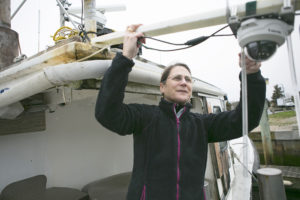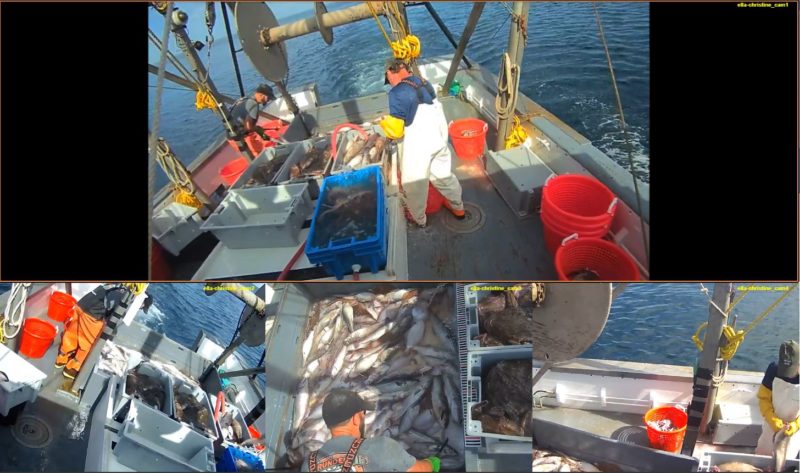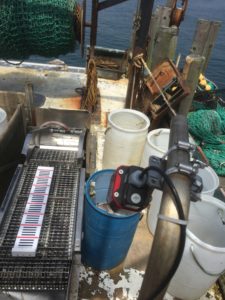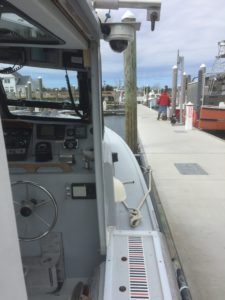Projects in the Field is a series of independently produced articles profiling work supported by NFWF’s Electronic Monitoring & Reporting Grant Program, and is meant to raise awareness and support for these important initiatives. The author welcomes your questions and comments.
“I understand that monitoring is expensive. NOT monitoring has been even costlier. As a small boat fisherman, I didn’t need a NMFS economist to tell me that 100% monitoring would hit small boats hardest. So, I’ve been involved in a pilot for the 100% EM Audit Model for several years. It is thorough, unobtrusive, and cost-effective. My understanding of the program is that costs decrease as fishermen improve their estimates of catch and discards, which in turn requires a lower audit rate. Cameras don’t breathe either, so nobody has to wear a mask.”
-Eric Hesse, F/V Tenacious II, West Barnstable, MA
More than 10% of New England’s active groundfish fishermen have embraced accountability, volunteering to run electronic monitoring cameras on 100% of their groundfish fishing trips when the rest of the fleet only has 0-40% coverage (zero during COVID waivers). These 21 fishermen are part of the Third-Party Audit Model pilot, now in its sixth year, and they represent jig, benthic longline, sink gillnet, and otter trawl gear types, on vessels ranging from 35 to 63 feet in length.

Over the course of the pilot, they have recorded video on more than 1,300 trips, providing essential data and feedback on how to best design an operational program. Their work has become critically important to allow the entirety of the unique and diverse groundfish fleet to transition to 100% monitoring, which was just approved by the New England Fishery Management Council on September 30th.
The EM programs being built for New England groundfish are unique in the country, the first to be rooted in the third-party service provider model. Given NOAA’s 2019 and 2020 policy directives to clarify EM cost allocation between government and industry, and the retention schedule for third-party EM video, we expect to see other fisheries around the country embrace this model and learn from the New England experience. Under the directive, the service provider will securely store the video for a minimum of 12 months from the date that NOAA Fisheries officially completes data reconciliation and catch monitoring for the fishing year. At that point it can be destroyed, minimizing fishermen’s concerns that the video will be at risk for misuse over the long term.

The Audit Model’s fundamental goal is to use EM video to validate the captain’s self-reported discards of allocated groundfish. The EM system runs on 100% of trips, the fishermen measure a sub-sample of their groundfish discards under the camera and report aggregated weight and count at the haul level.
Once the video hard drive is sent to the third-party EM service provider, a percentage (currently 50%) of the trips are randomly reviewed. The third-party reviewer lengths are extrapolated to weights and then compared to the captain’s electronic report. If the audited weights fall within prescribed tolerances levels, the fisherman’s data is used for catch accounting; if not, the reviewer’s data is used. After third-party reviewers watch and annotate the video footage from EM vessels, a subset of the footage is reviewed a second time by scientists at the Fisheries Sampling Branch of NOAA’s Northeast Fisheries Science Center. Both reviewers stream footage out of the cloud using the same secure, specialized review software to ensure that the reviews are comparable and that fishermen retain ownership of the raw video footage. As with most third-party models, the government has the responsibility to ensure that service providers can deliver the required services and to audit the service provider’s performance. In order to not be confused with the audit of the vessel trip report, we refer to this performance check as a “secondary review.”
In building the audit model program, the fishing industry and NGO partners have worked closely with Regional Office (GARFO) and Science Center (NEFSC) staff to experiment with program design and develop catch handling and review protocols, which are publicly available online. The secondary review occurred on 100% of EM trips for the first several years, providing a lot of comparisons and discussions. This collaborative approach has been critical to ironing out discrepancies, interpretation of review protocols, and expectations; it has produced some very good results.

One consistent bright spot for the audit model program over the last 5 years has been the tight alignment in video review reports between third-party and NEFSC reviewers. This shouldn’t be that surprising, since all the third-party reviewers are current or former NEFSC-trained fisheries observers. We have completed a comparison analysis between the EM reviewer and secondary review, to investigate the alignment between the reviewers. Results include:
- Differences in weight estimates were generally low (averaging < 5 lbs per trip),
- Average count differences were also low (generally < 2 fish per trip),
- In aggregate for FY19 there is less than a 0.5% difference in fish weights (72 lbs out of 20,199 lbs), and less than a 1.5% difference in count (460 out of 32,227).
In the uncertain times of COVID-19, electronic monitoring has provided a safe, flexible alternative to human monitors. In New England, EM data is the only monitoring data available to managers from March 20- August 14, as human observer

requirements were waived. Survey research cruises have been cancelled, but later this month the two fishing vessels participating in the industry longline survey will use EM to conduct the survey with or without federal scientists aboard. Now, more than ever, we need to embrace the value of EM data and pivot to using it in our science and management.
All this learning has been valuable to building a successful EM program. We are on the cusp of moving to a fully operational program next fishing year, and there is the opportunity for greater efficiencies and cost savings. For example, despite the consistent alignment between reviewers, the percentage of trips undergoing secondary review remains very high. There is a sizable labor cost invested in video review, and secondary review means that labor is required twice. As the audit pilot approaches an operational program in 2021, it is time to develop and publish clear, outcome-based standards that will help guide the purpose and frequency of the secondary review. This could be completed by secondary review of a trip completed by each individual reviewer on a regular schedule, maybe quarterly, with scored feedback. If the trip reviewed meets the predetermined standards, then further review would be unnecessary until the next quarter.
As we move forward, we must make sure that we are balancing risk with costs and not letting perfect be the enemy of the very good.
Melissa Sanderson is Chief Operating Officer of the Cape Cod Commercial Fishermen’s Alliance. The New England Groundfish Electronic Monitoring Audit Model Program is a collaborative effort between non-profit partners Cape Cod Commercial Fishermen’s Alliance, Maine Coast Fishermen’s Association, and The Nature Conservancy, EM service providers Teem Fish, SnapIT, and New England Marine Monitoring, and NOAA Fisheries staff at the Greater Atlantic Regional Fisheries Office and Northeast Fisheries Science Center.

